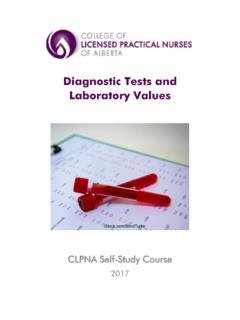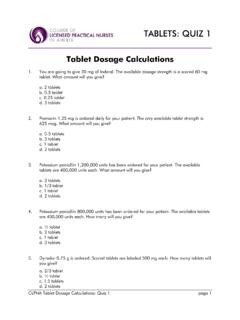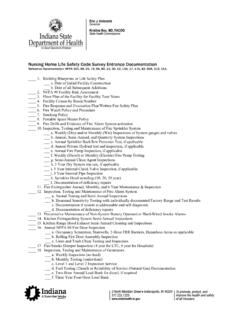Transcription of Nursing Documentation 101 101zzzzzzzzzzzzzzzzzzzzzzz
1 Nursing Documentation 101 101zzzzzzzzzzzzzzzzzzzzzzz This module is intended to support the continuing education of Alberta s Licensed Practical Nurses. Copyright College of Licensed Practical Nurses of Alberta 2014 2018 All rights reserved. The reproduction, storage in a retrieval system or transmission in any form or by any means (including electronic, mechanical, photographic, photocopying or recording) of any part of this publication without the prior written permission from the College of Licensed Practical Nurses of Alberta is an infringement of copyright law. College of Licensed Practical Nurses of Alberta 13163 146 Street NW Edmonton, Alberta T5L 4S8 CANADA Phone: 780-484-8886 Toll Free: 800-661-5877 Fax: 780-484-9069 Table of Contents Nursing Documentation 101 page i Table of Contents Module 1: Introduction .. 1 Purpose .. 1 The need .. 1 Course content .. 1 Learning components .. 2 Strategies for effective learning.
2 3 Module 2: The Importance of Accurate Documentation .. 4 Specific learning outcomes .. 4 Introduction .. 4 The health care environment .. 5 Who s looking .. 5 Methods of communication .. 6 Purposes of Documentation .. 6 Perceptions of Documentation .. 7 Challenges of Documentation .. 7 Standards of Documentation .. 9 Your employer s role .. 10 Consequences of inaccurate Documentation .. 10 Reflective questions .. 11 Key points .. 11 References .. 12 Module 3: Essential Elements of Accurate Documentation .. 13 Specific learning outcomes .. 13 Documentation deficiencies .. 13 Spelling and grammar who cares .. 15 Abbreviations .. 16 The Nursing process .. 16 For 18 Objective and subjective data .. 20 Inaccurate terms .. 20 Other strategies .. 22 Documentation methods .. 23 Advantages and disadvantages .. 23 Progress notes .. 24 Adverse events .. 25 Key points .. 26 Table of Contents Nursing Documentation 101 page ii Table of Contents References.
3 26 Module 4: Legal Issues Your Documentation is Evidence .. 27 Specific learning outcomes .. 27 Introduction .. 27 The legal process .. 27 The players .. 28 Problem areas of Documentation according to the lawyers .. 29 Electronic Documentation .. 30 Tips for improving the legal status of your Documentation .. 30 When a lawsuit proceeds .. 31 Key points .. 31 Reflective questions .. 32 References .. 33 Module 5: Applying Documentation Knowledge and Principles .. 34 Specific learning outcomes .. 34 Admission .. 34 Consent to treatment or procedure .. 36 Refusal of treatment .. 37 Physician or health care professional notification .. 37 Telephone calls and messages .. 39 Physician telephone orders .. 39 Post-operative care .. 40 Discharge from care .. 42 Discharge against medical advice .. 43 Health literacy .. 44 Client teaching .. 44 Family interactions .. 45 Client meetings .. 46 Medications .. 46 Medication errors .. 47 Client falls.
4 47 Client transfers .. 48 Cardiac arrest .. 49 Key points .. 49 Take away thoughts .. 50 References .. 50 Table of Contents Nursing Documentation 101 page iii Table of Contents Module 6: Electronic Documentation .. 51 Specific learning outcomes .. 51 Introduction .. 51 The electronic health record .. 52 Advantages of electronic Documentation .. 52 Challenges of technology .. 53 Confidentiality and security .. 54 Mobile devices .. 54 Key points .. 55 Reflection time .. 56 References .. 56 Module 1: Introduction Nursing Documentation 101 page 1 Module 1 Introduction to Nursing Documentation 101 Purpose ost health providers know that accurate Documentation (also known as charting, recording and reporting) is an important component of their professional and legal responsibilities. Nursing organizations have standards of practice (or practice guidelines) and specific competencies that address quality Documentation , not just good charting. The purpose of this Nursing Documentation course is to provide the knowledge and practical skills needed to ensure that accurate Documentation takes place in our health care systems.
5 The Documentation must not only meet professional and employer standards, but it must also be acceptable to our legal system. The Need The College of Licensed Practical Nurses of Alberta (CLPNA) has a number of good reasons for developing this course. First of all, Documentation was among the most frequently requested training from their members. Secondly, although most care providers believe that they do an adequate job of documenting, research and independent audits show that most Documentation fails to meet professional and legal standards. College committees and practice consultants agree that the deficiencies in Documentation are a significant issue. Discussions with health care employers, and even care providers themselves, echo similar concerns regarding inadequate and inappropriate Documentation . Finally, in many cases, Nursing Documentation has not met the criteria required by the legal system and has resulted in lost lawsuits. Course Content This Nursing Documentation consists of seven modules.
6 These are: 1. Module 1 An introduction and overview of the course. 2. Module 2 Importance of accurate Documentation . Topics include such things as Documentation in health care, and the purpose, perceptions, challenges and reasons for accurate Documentation . M Module 1: Introduction Nursing Documentation 101 page 2 3. Module 3 Essential elements of Documentation . The topics include common deficiencies, approved formats and terms, the Nursing process, strategies, and progress notes and documenting adverse events. 4. Module 4 Legal issues in Documentation . Some of the topics discussed include legal terms, what documents can be requested in a lawsuit, what lawyers are looking for, and how to reduce your liability and legal risks. 5. Module 5 Apply your Documentation knowledge. Topics include differentiating between accurate and inaccurate Documentation , and documenting in different situations and applications. 6. Module 6 Electronic Documentation . Since technology is becoming increasing prevalent in electronic health records, this module will give us an overview of how electronic Documentation works, advantages and disadvantages, some tips on what to do and not to do, and use of mobile devices at work.
7 7. Module 7 Additional exercises and resources. Learning Components The course is available on the Internet at It provides for many different components for learning, including: Narrated video presentations Podcasts Print handouts and notes Module quizzes Learning games Reflective exercises Practice exercises Final examination Module 1: Introduction Nursing Documentation 101 page 3 Strategies of Effective Learning Here are some suggestions for getting the most from this Documentation course. 1. Use the online video player controls smartly. You can pause a slide, replay it, or use the menu to go directly to another slide. The player features give you total control over the pace and direction of your learning! Take the short tutorial to familiarize yourself with the player controls. 2. Our second suggestion is that BEFORE you view a video, print out the handout for that Module. The handout provides you with a copy of the slides and our narration.
8 This makes it easier for you to follow along. Remember you can pause the presentation if you want to review what we said, or to make notes. 3. There is a lot of information in this course. Do not try to do the course all at one sitting. We learn better, and remember more, if we pace ourselves. Being online, this course and its components are available at all times and at any location where there is an Internet connection. Learn at your own convenience and comfortable pace. 4. Be sure to do the quizzes, games and interactive activities we have included in this course. They are fun, engaging and will help you learn better. 5. Finally, unless you are a Documentation expert, you will need to continue your learning. There will always be room for improving your Documentation . So we strongly recommend that you periodically return to repeat parts of this course. Review will be especially useful in those areas where you are having problems or feel you could do better. Module 2: Importance Nursing Documentation 101 page 4 Module 2 The Importance of Accurate Documentation Specific Learning Outcomes After successful completion of this module, you will be able to: Describe Documentation in the context of health care Name the organizations and individuals who may have access to client health records Review the purpose of Documentation Discuss care provider perceptions of Documentation Identify challenges health care providers experience in completing accurate Documentation Discuss societal factors that demand accurate Documentation Explain the link between Documentation and standards of practice Describe the role of an employing facility or agency s Documentation policies and procedures Introduction ocumentation is one of the main communication tools that both regulated and unregulated health care providers use to exchange client information.
9 According to Ashurst (2000), client records thirty years ago in hospital wards were limited to a series of classic statements that stated simple facts: Good day, no visitors today, good night, slept well, appears stable and tolerated procedure well . This type of Documentation is now widely viewed as ineffective and inappropriate. Furthermore, there was no evidence of ongoing assessments and re-evaluation of client condition and risks. To be clear, Documentation (sometimes called reporting, charting or recording) can be described as any electronic or written information or data about client interactions or care events that meet both legal and professional standards (College of Registered Nurses of British Columbia, 2012). Meeting legal standards refers to how your Documentation would be examined by the legal process or the court system. Your College (regulatory or licensing body) may also judge your Documentation to see if it meets their standards, competencies and expected behaviors that a prudent care provider would have.
10 Your employing facility or agency may also examine your Documentation to see if it meets their policies and procedures. Charting or Documentation audits across all health disciplines show serious deficiencies in Documentation . A recent study found that most Documentation efforts fail to meet legal and professional standards when examined (Paans, Sermus, Nieweg, & van der Schanns, 2010). This is in sharp contrast to the many care providers who believe that their charting is good or adequate . D Module 2: Importance Nursing Documentation 101 page 5 College committees and practice consultants also agree that deficiencies in Documentation are a significant issue. Anecdotal remarks from employing agencies and facilities and care providers themselves have reiterated similar concerns regarding inadequate and inappropriate charting. The Health Care Environment A large research report with its main partner, Health Canada (Blake & Norton, 2004), compared world-wide practices on patient safety and errors in health care.












